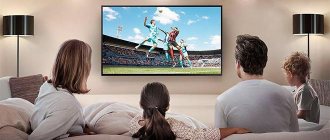HDR, or high dynamic range, is the latest technology for enhancing TV pictures. What is it, how does it work and where can I watch it?
Save and read later -
Every couple of years, a new technology appears with a name in the form of incomprehensible letters - UHD, 4K, HDCP or OLED. The latest of these innovations, HDR, or “high dynamic range,” is probably the biggest thing in the TV world right now.
This is quite a tricky thing, especially since HDR device manufacturers and content creators are implementing different technology standards.
What is it and what will make your picture even better? Let's talk.
Why is HDR so good?
Look at the sky. White clouds are characterized by volume and multi-layeredness, and the eye distinguishes different degrees of brightness. However, on a TV screen the clouds look flat, the white color is less developed, and the layering disappears.
There are several reasons for this, the first of which is the limited dynamic range of the TV and its inability to convey minute changes in brightness. The human eye is able to discern many more nuances than TV can convey. Secondly, image processing at all stages of film creation is to blame. It radically reduces the amount of transmitted information in order to fit it into the technical limitations of the television format.
And finally, TVs are becoming more advanced. The brightness of a typical TV is 100-300 nits, where one nit is equivalent to the light from one candle. The average HDR TV is closer to 1000 nits. However, the point of HDR is not to illuminate a room, but to expand the color palette to show subtle changes in the penumbra.
Bright and shadowed objects will become more detailed; the sense of depth will be more clear. Colors will become richer and more realistic, with more subtle gradations and tonal transitions. In general, the picture will become more natural.
Advantages
HDR technology has undeniable advantages that are always noticeable. If the positive effect of increased resolution for most people will be obvious only close to the screen or at a large diagonal, then the extended dynamic range will be appreciated by everyone at any adequate distance. This is due to the peculiarities of perception and human vision.
Advantages of TVs with HDR:
- bright picture – TVs with HDR show complex scenes, where the brightness is much higher than that of the screens of classic models, and it can be different for individual objects;
- color saturation - an expanded range of shades allows you to make the image more saturated, deep and pleasing to the eye, it also helps the director to realize more ideas and demonstrate the work in the desired form;
- detail – increased levels of brightness and color saturation allow you to display more details in the frame, which makes the image full and beautiful.
Only premium TV models can realize 100% of the potential of extended dynamic range. However, even budget options with HDR10 have the same advantages, but a little less pronounced.
HDR and 4K Ultra HD
HDR should not be confused with another buzzy term - UHD (Ultra High Definition), also known as 4K resolution. Both HDR and UHD improve images, but in different ways: UHD increases the number of pixels, while HDR tends to make the existing ones more accurate.
At the same time, 4K and HDR technologies often go together. Most HDR-compatible TVs on the market are also 4K-Ultra-HD models; even Sony's 2021 Full-HD lineup supports HDR, unlike some less expensive 4K TVs.
Availability of HDR on TV
Sometimes people buy a TV based only on screen resolution or without thinking about its capabilities at all. And the presence of HDR technology in the model can be an extremely pleasant surprise.
Is it supported
The easiest way to find out if a TV supports HDR is before you buy it. It is enough to familiarize yourself with the technical characteristics of the model and find the appropriate item. You can do the same with an already purchased TV. You need to find this model on the manufacturer’s or store’s website and check its characteristics.
Also, the presence of HDR can be determined by the box. If it says Ultra HD Premium, then this indicates full support for extended dynamic range and the premium class of the TV. The presence of the 4K HDR label also indicates compatibility with the new technology. However, in such cases, high dynamic range support may be limited to a single format.
If the box is lost or does not have convincing inscriptions, then you can check the presence of HDR in the technical documentation from the TV. It contains all the functions and characteristics, including support for extended dynamic range.
How to turn it on
In most cases, no special actions are required to activate the HDR mode, since it is enabled initially. Sometimes it can be deactivated in the settings of the TV itself. Then it will be enough to switch it to the active state.
To run video in high dynamic range mode, you also don't have to do anything special. All you have to do is play the selected content. Activated HDR will be immediately noticeable.
If the TV does not support this technology, a corresponding error will appear on the screen. It will tell you about the incompatibility of the format of the content being played and the TV model being used.
If initially HDR was a promising technology and was found only in expensive TV models, then later the situation changed. Now it is difficult to imagine TV without support for the dynamic range of this format. And people who have at least once seen the benefits of the new technology will always notice the difference between classic TVs and those models that are compatible with HDR.
TV catalogue, compare prices and read reviews
What is HDR10?
Today there are as many as five varieties of HDR: HDR10, HDR10+, HLG, Dolby Vision and Advanced HDR from Technicolor. HDR10 is the original and most common form. This open standard has been adopted by many manufacturers, service providers (Amazon, Netflix) and the Blu-ray Disc Association (BDA).
The Consumer Electronics Association (CEA) has defined standards that HDR10 must meet, including 4:2:0 chroma subsampling, 10-bit bit depth, and BT.2020 color space.
Generally, all current and future 4K TVs support HDR10. This ensures the TV is compatible with most available 4K Blu-ray discs, players and streaming content - and provides better picture quality than non-HDR 4K TVs.
Connecting HDR equipment
You don't need new cords to play HDR content. An HDMI High Speed cable will suffice. New TVs support this interface. Therefore, there should be no connection problems. In situations where equipment is connected using an AV receiver, you must first make sure that the tuner is equipped with an HDMI 2.0 interface. Many manufacturers have carried out large-scale interface updates. Therefore, the HDMI 2.0 connector can no longer be called a rarity. To turn on the TV, simply plug the power cord into the outlet. Then select the signal source. You can play content using special applications, such as Netflix.
What is Dolby Vision?
Dolby Vision HDR technology was originally developed for Dolby Cinema, but can be adapted for the home. Its main difference is the addition of dynamic metadata to the base HDR image. Because of this, image enhancement can be performed frame by frame, while static HDR10 is applied only to the entire film - both the darkest and lightest frames.
Netflix and Amazon Prime Video offer content in both formats, and 4K-Blu-ray combo discs have already been released. However, the Dolby format is still less common.
To view content in Dolby Vision, you will need a compatible Blu-ray player, AV receiver and TV; the list of such models is much shorter than for HDR10. Using Dolby Vision requires a license fee, which reduces the number of TVs and Blu-ray players that support it. LG remains the format's biggest proponent; many of LG's 2021 LCD and OLED TVs and all of its 2021 OLED models support it.
Theoretically, the Dolby Vision format is capable of creating a better picture compared to HDR10, but this depends on the quality of its implementation.
HDR TV nuances
For a television receiver, HDR is determined by two things:
- What level of contrast is it capable of displaying?
- What is the quantity and quality of reproduced colors?
Moreover, contrast is considered the most important factor. It displays the difference between the brightness of the lightest and darkest areas on each frame. The higher this indicator, the higher the contrast level. The brightness of the night sky strewn with stars is 0.003 nits, the celestial body is 1.6 billion nits. The main task of the TV is to correctly display this range in the presence of extreme set values characterizing brightness, from one to five hundred nits.
For a TV to qualify for HDR, it must have a certain peak brightness threshold. But this is not the only parameter set, because we must not forget about the black level value. It determines how brightly the dark areas of the picture will be reflected.
Color is an equally important parameter in HDR. The receiver must process color, which is usually called “deep” or ten-bit. For clarity, let's say that in Blu-ray it is customary to use eight-bit color, which can display about sixteen million different shades. Whereas the ten-bit color of HDR TV receivers creates a significantly expanded range of color gamuts, making it possible to smooth out the gradation between them.
But in fairness, it must be said that there are some nuances here. To fully combine with HDR, it is not at all necessary for the TV to display all colors in a ten-bit signal. It simply requires the presence of a function for processing this signal and it must reproduce a picture created on the basis of the received information, which is usually called metadata.
If we talk about P3 color gamut, then the TV is considered compliant with the HDR standard, provided that it has the ability to cover more space in the color spectrum. And the smoothness of transitions between different shades in a given space will be much better than is the case with ordinary TVs.
What is HDR10+?
Samsung has developed its own HDR standard – HDR10+. Like Dolby Vision HDR, it uses dynamic metadata to enhance images frame by frame.
None of Samsung's models support Dolby Vision, and it's no exaggeration to say that HDR10+ was designed as a direct competitor. Unlike Dolby's, it is open source and largely free, making it more accessible to producers.
All 2021 Samsung 4K TVs natively support HDR10+, and a firmware update makes it available for 2016 4K models.
In an effort to expand the use of its format, the company is attracting others from the industry. It was recently announced that Panasonic and 20th Century Fox will license the HDR10+ platform. Amazon Prime Video is the first content provider to announce support for HDR10+; the service promises more than 100 programs in this format.
Quantum mechanics in television
The main advantage of the Samsung 55Q8C (and all Samsung QLED ) over anything that shows cinema is the excellent 55-inch curved 4K quantum dot panel, QLED.
This is one of the types of LCD displays, differing in the backlight principle. THIS IS INTERESTING: Quantum dot displays have an additional layer in a matrix of nanoparticles. Nanoparticles of different sizes help produce different colors. Light passing through this layer becomes more uniform and saturated.
Thus, the layer of quantum dots allows you to increase the brightness of the screen without losing color saturation.
There are other features too. Thus, all Samsung TVs based on quantum dots (with QLED screens) comply with the HDR1500 standard: the display brightness is 1500 nits. Enough to enjoy a rich picture without loss of contrast even in the brightest scenes.
FOR REFERENCE: Regular TVs and monitors offer 350-500 nits. 3-5 times less than Samsung Q8C!
Simply put, quantum dot displays convey more colors, and do so as faithfully as possible to the human eye. Where we see darkness on a regular screen, the QLED panel conveys transitions and shadows as we see in real life.
What is HLG?
HLG (Hybrid Log Gamma) is perhaps the most promising of the HDR formats, as it will be used in television broadcasts.
The result of a joint research project between the BBC (UK) and NHK (Japan), HLG promises to be more convenient than HDR10 for broadcast around the world. In this format, standard and high dynamic range video signals are transmitted together, allowing HLG-compatible 4K TVs to decode and playback the HDR signal in all its glory.
The most famous manufacturers have already confirmed that their 2017 models support HLG; 2021 HDR TVs from Samsung, Sony and LG have received HLG support with a firmware update. Panasonic promises the same for the top of the line 2021 models. And if the infrastructure is in place, the content will not take long to arrive.
For now, HLG content can only be enjoyed on BBC Blue Planet II, available in 4K and HLG on BBC iPlayer from January this year. The seven-episode program proves that HLG works – and looks fantastic.
This raises hopes for future 4K HLG broadcasts, although the BBC has announced that it will offer UHD and HDR content on the iPlayer platform rather than on a separate channel.
What will the new television be like? We talk about 4K HDR, a new stage of development
Ultra-high definition television has rapidly entered our lives. Nowadays, neither video with a resolution of 3840 by 2160 pixels, nor games that support this resolution seem unrealistic. Both online cinemas and satellite television operators broadcast in Ultra HD format. Monitors, TVs and projectors with 4K resolution (which usually means those same 3840 by 2160 pixels, or, less commonly, 4096 by 2160) are represented on the market by a large number of models, while only projectors remain relatively expensive, while monitors and TVs prices are already available to the mass buyer. The very essence of doubling the resolution when moving from Full HD to 4K UHD is clear to consumers and does not require special explanation - higher resolution, higher clarity, image detail, you can sit closer to the screen so that the pixel structure is not visible and the picture covers a larger viewing angle, that is, the image approaches reality, what a person sees in the world around him.
The next step in the visualization industry is the introduction of high dynamic range or HDR (from h
igh
d
ynamic
range
), which in combination with ultra-high resolution leads to the concept of
4K HDR
. HDR - what is it? Why do you need HDR on a TV or projector? What does the user get from HDR? We will try to give answers to these questions, but let everyone decide for themselves whether it is worth paying extra for HDR or changing the TV to a model that supports HDR.
Human vision can operate over a huge range of brightness, namely from 0.000001 cd/m² to 100,000,000 cd/m². For those familiar with photography and videography, this corresponds to approximately 46.5 stops of exposure. In this case, the so-called night vision works up to 0.01 cd/m². Under these conditions, photoreceptors with high sensitivity - rods - are active. Night vision features include low resolution and lack of ability to distinguish colors. In conditions with a brightness exceeding 10 cd/m², photoreceptors of a different type - cones - work, and vision becomes daytime, with high resolution and color. In conditions of transition from 0.01 to 10 cd/m², vision is twilight, combining the properties of night and day. Obviously, in order for the image to be color and retain detail, the lower limit of the brightness of the darkest shades should be in the twilight vision zone and, preferably, closer to the limit of daylight vision.
The upper limit is helped by the fact that the established visual contrast is at the level of 5000:1, or just over 12 exposure stops. This is due to the fact that human vision, with the help of various mechanical (pupillary reaction), photochemical and neural adaptive processes, adapts to environmental conditions so as to maintain maximum efficiency. As a result, for example, for 0.1-1 cd/m² perceived by the eye as black, we will obtain the required brightness of white at a level of 500-5000 cd/m².
Thus, in order to be able to transmit an image as close as possible to what a person sees in real life, the TV must display a bright and contrasty picture, with a final static dynamic range of about 5000:1. In this case, it is better if the real dynamic range is higher than this value in order to compensate for the adaptation of vision to changes in the average brightness on the screen and to the level of illumination in the room.
However, in the case of video, HDR support does not mean only high brightness and contrast. Digital video means that the brightness levels of the shades are encoded by numbers with a limited range of values. For example, for a typical video, the brightness of each of the three colors - red, green and blue - is encoded using values from 16 (black) to 235 (white), giving a total of 220 gradations of brightness of one color or shades on the gray scale (8-bit number per color). Such a small number of steps leads to a significant difference in the brightness of neighboring shades, which in relative terms increases as the lightness of the shade decreases. Moreover, if the relative difference in brightness reaches 2% (for dark shades this threshold increases), then the boundary between shades may already be visually noticeable, the image acquires characteristic striping and becomes unnatural. In fact, if we take the brightness below which banding can be noticeable as the lower limit, then in the case of conventional 8-bit color encoding the dynamic range will be only about 40:1, and we, as described above, want to get a minimum of 5000:1, and so that there are no artifacts. Of course, usually the banding effect due to spatial and dynamic color mixing in the case of natural images obtained from a camera is weak or absent even for an 8-bit image, but such a dependence on conditions is unacceptable. The obvious solution is to increase the number of shade gradations, that is, encode brightness levels not with 8-bits, but with 10 or 12-bit numbers. Additionally, you can use special dependences (transfer functions) of brightness on the numerical value of the hue, which keep the difference in brightness between shades less than the change noticeable to the eye throughout the entire brightness range. The resulting combination of high brightness, contrast and the absence of artifacts (banding) in the entire range of shades can already be the basis for displaying an image that is as close as possible to what a person sees in the real world. This is the basic principle of HDR.
Note that HDR technology implies compliance with the necessary conditions throughout all stages: shooting in HDR, processing in HDR, storage in a format that supports HDR, transfer to a display device and actual output in HDR. Currently, several HDR standards have been adopted. The most common seem to be three, namely HDR10, Dolby Vision and Hybrid Log-Gamma. Depending on the standard, in addition to the image itself, additional static data and dynamic data can be transmitted, specific for each scene, helping the display device achieve even greater realism.
What about 4K HDR
, how accessible is it at the moment?
Online services that provide video streaming in up to 4K HDR promising sources of Currently, you can watch films in this format in online cinemas, for example, Amazon Video and Netflix, the domestic Okko, in addition, there are videos in 4K HDR on YouTube. Another source of 4K HDR content is games, in particular the Sony PlayStation 4 Pro game console supports 4K HDR output for almost 80 games, in particular Horizon Zero Dawn.
As an example of a display device that supports 4K HDR, consider the Sony BRAVIA XE94, XE93 and XE90 series TVs.
The new BRAVIA XE93/XE94 series, in addition to the HDR10 standard, also support the Dolby Vision standard, an HDR format developed by Dolby Laboratories, and with the release of a software update, we can expect support for Hybrid Log Gamma, the third common HDR standard.
The XE93 Series' Slim Backlight Drive+ technology provides more precise control over local dimming. Thanks to a special LED edge lighting system (the light panel is equipped with a double block of LEDs), high brightness and contrast of the image are ensured while maintaining the thinnest possible body. The XE94 series TVs are equipped with a carpet backlighting system (over the entire surface of the matrix) with local dimming.
4K HDR X1 Extreme Processor
The XE94/XE93 series delivers high image quality through three new technologies: Object-based HDR remastering, Super Bit Mapping 4K HDR for smooth color transitions, and signal processing using two databases ( Dual database processing), one of which is responsible for noise reduction, and the second for improving image quality.
X-tended Dynamic Range PRO technology enhances video quality in a variety of formats, including HDR, by adjusting the backlight brightness in specific areas of the screen.
TRILUMINOS Display technology further enhances brightness and color accuracy. Thanks to a wider palette of colors and more natural shades, the image becomes more attractive.
The body design of the new line of TVs is made in 360° format - these models look great from any angle. The thin body and special cable management system allow the TV to fit seamlessly into any interior. The models of the new line feature an original system for hidden cable placement inside the stand.
They will remain invisible no matter from which side you look at the TV. For example, the switching on the back of the XE94/X93 series TVs is hidden behind a stylish panel made of high-quality plastic with a mesh pattern. Individual panel elements can be easily removed for quick access to connectors and connecting external devices. This design solution strikes a compromise between style and functionality - the TV looks attractive no matter how you look at it, while at the same time providing all possible connectivity options.
For wall mounting of the XE93/XE94 series TVs, a special swivel bracket was developed that allows you to change the angle of the TV screen so that you can easily reach the connectors if necessary.
Sony BRAVIA XE94, XE93 and XE90 series TVs are equipped with Android TV 6.0 (Marshmallow) pre-installed, which provides improved interface design, intuitive operation and new features. For ease of use of voice search, a separate button has been added to the remote control. The new operating system allows you to use external devices as additional TV memory (storing applications and media files up to 1 exabyst), and also makes it easier to search for content thanks to a new filtering system by genre.
Main characteristics:
| XE94 series | XE93 series | XE90 Series | |
| HDR support | 4K HDR | 4K HDR | 4K HDR |
| Android TV | 6.0 Marshmallow | 6.0 Marshmallow | 6.0 Marshmallow |
| Screen backlight | Direct LED | Slim Backlight Drive+ | Direct LED |
| CPU | 4K HDR processor X1 Extreme | 4K HDR processor X1 Extreme | 4K HDR Processor X1 |
| Screen backlight | Direct LED | Slim Backlight Drive+ | Direct LED |
| Image enhancement technologies | TRILUMINOS Display, X-tended Dynamic Range PRO, 4K X-Reality Pro | TRILUMINOS Display, X-tended Dynamic Range PRO, 4K X-Reality Pro | TRILUMINOS Display, X-tended Dynamic Range PRO, 4K X-Reality Pro |
| Screen sizes (inches) as of launch date | 75 | 65/55 | 75/65/55/49 |
Overall, 4K HDR
, very good, manufacturers are offering more and more models of ultra-high resolution TVs and projectors with HDR support, and the quantity and availability of relevant content is increasing.
What is Advanced HDR?
Advanced HDR from Technicolor is another new HDR format introduced at CES 2021. It is the result of a collaboration between LG and video specialist Technicolor. As with other types of HDR, content must be mastered in the desired format and played back on a source capable of reading Advanced HDR data and a compatible TV or projector.
Some 2021 LG TV models, 4K OLED and LCD, support the format, but nothing has been heard about the content yet.
What does it look like?
Let's try to figure it out and start by explaining the essence of the technology.
Any TV is characterized by contrast and color accuracy. Contrast affects how bright and dark colors a device can display while still being visible to the viewer. Color accuracy, in turn, means how close to real colors will be displayed on the screen.
It is curious that most potential buyers, if offered a choice of a TV with a higher resolution and a TV with a lower resolution but higher contrast, will choose the second. It is the saturation and variety of colors that are the priority when choosing. Thus, the brightness of the picture remains preferable to resolutions above 4K. Buyers choose with their eyes.
How and where to watch HDR?
To view HDR10 and Dolby Vision at home, you will need a compatible display: TV, projector, smartphone or tablet. LG, Samsung, Sony, Panasonic and Philips have already released their own HDR TV models.
The next step is to find the source. Requires content that was originally produced in or converted to HDR; Regular video recordings on an HDR screen won't work as well as they should. Today there are already dozens of Ultra-HD-4KBlu-ray discs in the HDR10 format on sale, and new ones are released every month. Streaming services such as Netflix and Amazon Prime Video also offer a lot of HDR content - usually also in 4K.
If your HDR movie is on disc, you will need an Ultra-HD Blu-ray player. Of the available options, our favorites are the Cambridge CXUHD, Sony UBP-X800 and Oppo UDP-203. Microsoft Xbox One S and Xbox One X consoles also play 4K Blu discs and support HDR10.
HDR streaming can be enjoyed using a compatible TV app or media player, such as the latest Amazon Fire TV or Apple TV 4K (the latter also offers 4K HDR movies via iTunes). This will require a high speed Internet connection.
The best TV is the one that's invisible
To make the user believe what is happening on the TV screen, you need to remove the TV, leaving only the image.
The main difference between Samsung QLED TVs is the almost complete absence of frames and wires. TVs in this series can be called frameless, like Samsung S8 series smartphones. To remove the wires, I had to use a trick.
The TV itself is absolutely smooth on both sides. All interfaces are placed in a separate One Connect block, connected to the TV with a thin translucent optical cable.
No wires, no frames - the TV has disappeared into your interior. The optical cable is hidden in the stand of the TV itself and is discreetly routed to the One Connect unit, to which all other devices are connected (DVD player, game console, etc.). The unit can be placed in any convenient place at a distance of up to 5 meters from the TV. And all connected devices can be controlled from one remote control (One Remote).
Samsung has achieved what all manufacturers have been striving for for many years.
Samsung Q8C will make you fall in love with cinema again
New video standards are literally forcing us to change TVs and monitors. The difference between 4K HDR and Full HD is not just noticeable - they are 2 different pictures. More details, colors, dynamics - more emotions, empathy, sensations.
This standard has not yet conquered the market. Not many films have been made, and you can only watch them on a few resources or from disks.
But HDR is the future. Without HDR support, a TV is no longer needed.
The best choice for viewing this kind of content is the Samsung Q8C, thanks to its truly user-friendly system and floating screen. All this greatly improves the experience, making you forget about the existence of the TV itself.
Expensive? You won't find a cheaper price in class. You just have to see, and all questions will disappear by themselves.
(
1 votes, overall rating: 5.00 out of 5)











